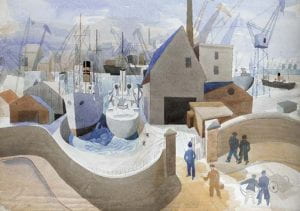
Cessnock in Summer depicts an industrial landscape in the burgh of Govan. Big ships were built there, goods traded across the Atlantic. The colours are pale, bright enough but hemmed in by upright shapes and blocks of black. The human figures cluster at the bottom right, their space invaded by the sea. This is a painting with social and political meanings, related specifically to a Scottish place.
When Scotland’s society and/or politics is noticeably distinctive then it causes friction with other British people. Murray Pittock tracked this by analysing the perception of Scottishness by media in England, post-1707. His article is fascinating (link below). He concluded that negative stereotyping waxed when the Scots were noticeably different, waned when they were not. Any Scottish behaviour thought to challenge or take advantage of existing arrangements was met with an outbreak of complaint that contrasted English virtues with Scottish vices. This perhaps explains why modern British red-top newspapers and right-wing politicians are so forthright about characterising anti-Brexit Scots as parasites and subsidy junkies. At the election in December 2019, 74.9% Scots voters did not support the current UK government.
Murray Pittock (2009) To See Ourselves as Others See Us European Journal of English Studies, 13:3, 293-304.